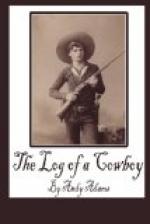The site chosen for the bridge was a miry bottom over which oozed three or four inches of water, where the width of the stream was about sixty feet, with solid banks on either side. To get a good foundation was the most important matter, but the brush from the trees would supply the material for that; and within an hour, brush began to arrive, dragged from the pommels of saddles, and was piled into the stream. About this time a call went out for a volunteer who could drive oxen, for the darky was too good an axeman to be recalled. As I had driven oxen as a boy, I was going to offer my services, when Joe Stallings eagerly volunteered in order to avoid using an axe. Slaughter had some extra chain, and our four mules were pressed into service as an extra team in snaking logs. As McCann was to provide for the inner man, the mule team fell to me; and putting my saddle on the nigh wheeler, I rode jauntily past Mr. Stallings as he trudged alongside his two yoke of oxen.
About ten o’clock in the morning, George Jacklin, the foreman of the Millet herd, rode up with several of his men, and seeing the bridge taking shape, turned in and assisted in dragging brush for the foundation. By the time all hands knocked off for dinner, we had a foundation of brush twenty feet wide and four feet high, to say nothing about what had sunk in the mire. The logs were cut about fourteen feet long, and old Joe and I had snaked them up as fast as the axemen could get them ready. Jacklin returned to his wagon for dinner and a change of horses, though Slaughter, with plenty of assurance, had invited him to eat with us, and when he declined had remarked, with no less confidence, “Well, then, you’ll be back right after dinner. And say, bring all the men you can spare; and if you’ve got any gunny sacks or old tarpaulins, bring them; and by all means don’t forget your spade.”
Pete Slaughter was a harsh master, considering he was working volunteer labor; but then we all felt a common interest in the bridge, for if Slaughter’s beeves could cross, ours could, and so could Millet’s. All the men dragging brush changed horses during dinner, for there was to be no pause in piling in a good foundation as long as the material was at hand. Jacklin and his outfit returned, ten strong, and with thirty men at work, the bridge grew. They began laying the logs on the brush after dinner, and the work of sodding the bridge went forward at the same time. The bridge stood about two feet above the water in the creek, but when near the middle of the stream was reached, the foundation gave way, and for an hour ten horses were kept busy dragging brush to fill that sink hole until it would bear the weight of the logs. We had used all the acceptable timber on our side of the stream for half a mile either way, and yet there were not enough logs to complete the bridge. When we lacked only some ten or twelve logs, Slaughter had the boys sod a narrow strip across the remaining brush, and the horsemen led their mounts across to the farther side. Then the axemen crossed, felled the nearest trees, and the last logs were dragged up from the pommels of our saddles.




